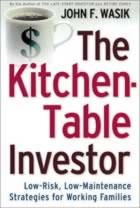The Kitchen-Table Investor: Wealth-Building Strategies for Working Families
 As you might expect, most of my personal investments are safely tucked away in index funds, those mutual funds designed to track the performance of a particular stock market index. This is a smart way for the average investor to achieve solid growth over the long-term.
As you might expect, most of my personal investments are safely tucked away in index funds, those mutual funds designed to track the performance of a particular stock market index. This is a smart way for the average investor to achieve solid growth over the long-term.
However, I continue to hold about 5% of my investment capital in reserve as “mad money”. While the rest of my investments are conservative, I use this money to purchase whatever investment strikes my fancy.
I don't do a good job.
In 2006 I gained about 20% with my mad money. Last year I lost about 33%. I've lost even more this year. I'm just not educated enough to pick and choose individual stocks. I buy and sell at the wrong times. Obviously, this is further anecdotal evidence in support of index funds. Undaunted, I recently made a trip to the library to borrow a book about individual investing, John Wasik's The Kitchen-Table Investor: Low-Risk, Low-Maintenance Wealth-Building Strategies for Working Families.
At first, the book made me wary. In the preface, Wasik writes:
My low-risk, long-term strategy makes it possible for any investor to share in the great wealth Wall Street is producing — by investing as little as $25 a month…By following a handful of rules, real wealth is certainly attainable even if you don't have the the money to invest. I'll not only show you how to invest small sums of money but help you find the money to invest automatically on a regular basis.
Real wealth is attainable even without money to invest? What? Despite this bold claim, this book is not a get-rich-quick screed. Wasik offers sound personal finance advice. In fact, his philosophy often echoes classics like Your Money or Your Life: “In saving money, we are preserving our own natural resources, that is, our life energy.”
Wasik's approach to low-maintenance investing follows eight steps. Here are my comments on each:
Find money to invest
Wasik preaches the virtues of compound interest: “If you can save at least 10% of your annual income — no matter how much you make — you will have [prosperity].” But how do you find the money to save? Avoid advertising, Wasik says, especially television advertising. Avoid credit card debt. Buy a sensible home and a sensible car. Spend less than you earn.
Join an investment club
Wasik is a huge fan of investment clubs. These groups provide amateur investors with an opportunity to pool their money to make larger purchases. They also teach members to research stocks and to track their portfolios. The book contains a lot of good information on running an effective investment club.
Find a place to park your money
You need someplace to stash your money while you're saving to make your stock purchases. Wasik recommends money market funds. Nowadays, parking the money in a high-yield savings account probably makes the most sense. (Many of these are money market funds, anyhow.)
Fund your company plans
“Welcome to the golden age of retirement vehicles,” Wasik says. He provides an overview of various pension plans, including 401(k)s, 403(b)s, traditional IRAs, and Roth IRAs. “Fund your plans for maximum growth,” he recommends.
Buy stocks for growth
Wasik offers his five fundamental rules of stock-picking:
- Find quality companies that are growing earnings consistently from 10% to 15% per year.
- Sales and earnings per share should be increasing in lockstep with earnings. Look for companies with at least five years of earnings.
- Buy a stock for the long term.
- Keep your costs low and your commitment high. Reinvest all dividends.
- Automatically purchase shares on a regular basis to reduce market risk.
He offers tips on screening companies, and explains how to read an annual report.
Buy mutual funds
What if you don't want to pick individual stocks? What if you're not interested in gambling whether you can beat the market? Create a portfolio comprising four essential mutual funds: one that tracks the Wilshire 5000 index, an international fund, a value fund, and a “wild card” fund. The latter can be any aggressive fund that focuses on one sector of the economy.
Be patient
Don't panic. “Investing is a matter of rational faith,” says Wasik. Buy and hold. Don't pay attention to the financial report. Don't check your stock prices every day. Don't try to second guess the market. Be patient, rebalancing your portfolio every year. Accept the risk and sleep at night.
Become an automatic investor
Wasik loses his way in the final chapter. This ought to have read like David Bach's The Automatic Millionaire. Instead, it's a list of ways to save money through frugality. That's fine, but it has nothing to do with automatic investing.
The Kitchen-Table Investor is not a bad book — in fact, I think it would be quite useful for many Get Rich Slowly readers — it's just not everything I had hoped. Still, bits and pieces are quite good. I like that Wasik provides examples from his own life. He's not afraid to share the mistakes he's made in order to illustrate a point.
Though some of the book's advice is dated, and there's more delivery than payoff, The Kitchen-Table Investor is worth reading if you're interested in a more active approach to self-directed investing. If you want to try picking your own stocks, then consider borrowing this book from your local library. It'll give you a solid introduction to the basics.
Become A Money Boss And Join 15,000 Others
Subscribe to the GRS Insider (FREE) and we’ll give you a copy of the Money Boss Manifesto (also FREE)
